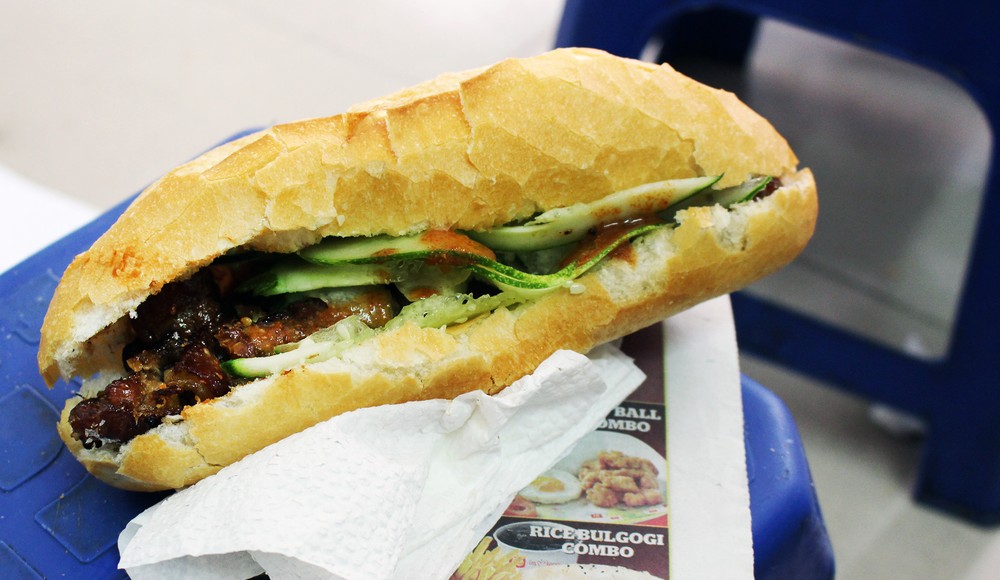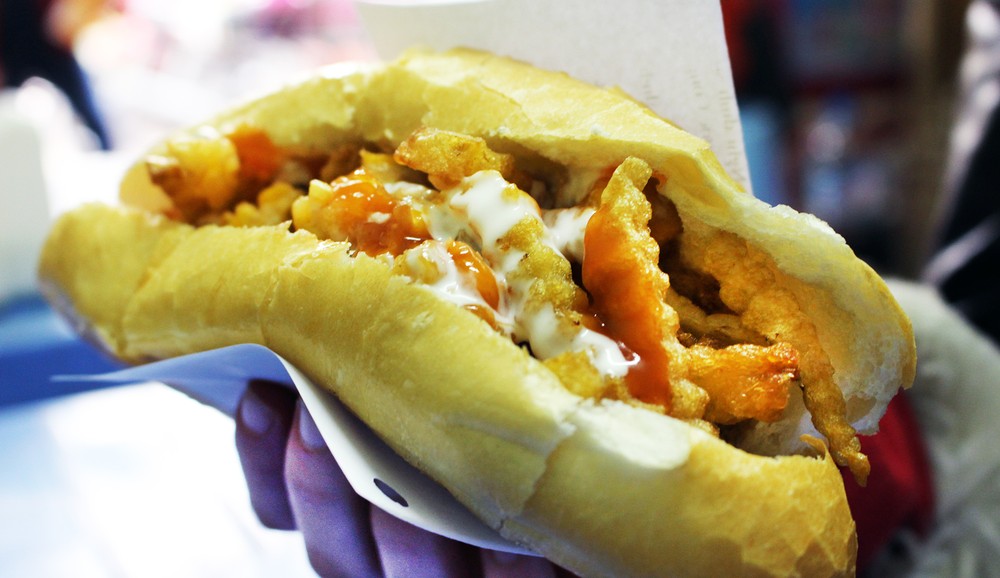Ever since Vietnamese immigrants started selling banh mi in the US, the sandwiches have been absorbed into American culinary culture, used to showcase ingredients from traditional pork and pâté to tempeh and sardines.
But even if you think you know banh mi, you’ll be surprised by the ones served in Vietnam’s capital, where they’re a completely different breed from the southern loaves that inspire most American offerings.
Videos by VICE
“Hanoi banh mi have more variety in ingredients, from traditional egg and pâté to modern sausage and skewered pork. Ho Chi Minh City banh mi are usually the same combination of pork, pâté, chả and vegetables,” says food writer Huyen Tran. “I think southern people only eat this type of banh mi and don’t prefer variations like Hanoians.”
Banh mi in the capital are also less colorful than their southern Vietnamese counterparts, with simple garnishes that reflect the comparative subtlety of northern cuisine in contrast to the layered sweetness that pervades southern fare.”Southern banh mi are filled with meat and sweet chili sauce. The sweet flavor is very strong,” points out Trang Le, one of the founders of Hanoi eatery Banh-Mee.
Their name is even pronounced differently in northern Vietnam, where the final “h” is pronounced like a “g.” Instead of “bahn mee,” think “bang me.”
Despite their simplicity, Hanoi banh mi are far from boring. Alongside classics like fried egg and grilled pork, vendors are creating new mashups that wouldn’t be out of place in New York’s culinary scene (French fries and fermented sausage, anyone?)—though likely for a fraction of the price. Here’s a rundown of the city’s best banh mi:
OLD SCHOOL

Banh mi pa te
The French colonists left a visible influence on Vietnamese cuisine, from the crusty bread that forms the base of the sandwich to the pâté that remains one of the most popular fillings. Many complain that the spread has declined in quality, with cheap industrial products replacing the homemade version. At Banh My Lan Ong, however, the duck pâté is still made fresh every morning by the family of the original owner, who is now 87 years old.

The sandwich itself has not changed in the 30 years since the shop opened in the heart of Hanoi’s Old Quarter. There’s no menu—just order one banh mi, and you’ll get bread with a thick spread of pâté, topped with pork floss, crunchy fried shallots, cucumber, cilantro, and chili sauce (all for 20,000 dong, or about 94 cents). The loaves rest in a small electric oven, ensuring that they stay warm and crusty. To keep things authentically French, ask for an extra layer of butter.

Banh mi trung
Fiercely proud of their city, Hanoians can debate for hours about the best phở joint or cafe. But ask for egg sandwich recommendations and locals shrug, a testament to the ubiquitousness of this humble sandwich.
“It’s something taken for granted. People just drive around and think any street-side joint is fine,” Tran explained to me.
Vendor Thuan has been selling banh mi outside her apartment complex in central Hoan Kiem District for more than 20 years. To make her no-frills banh mi trứng ngải cứu, (13,000 dong), she cracks two eggs into a plastic container and adds a handful of ngai cuu (mugwort leaves), then scrambles it all in a battered pan trembling on a charcoal burner. The herbs have an intoxicatingly bittersweet flavor that pairs well with the creamy eggs.
In her free moments, Thuan reads Vietnamese classic literature. On a recent afternoon, she was reading Truyen Kieu by Nguyen Du and offering to tell a customer’s fortune based on the story.
“Even though I’m just selling banh mi on the street, I love poetry,” she said proudly.

Banh mi thit xien
On cold, hazy afternoons, vendors cook these grilled pork skewers over curbside grills, their rich aroma tempting passing drivers. Banh Mi Thit Xien Ba Nga is one of the most popular addresses in Hoan Kiem District. Originally a street stall, it’s since expanded to a full-fledged shop where you can relax on a plastic stool and enjoy your sandwich with iced green tea or soymilk.
Skewers of tender pork cost 10,000 dong each, with an additional 3,000 dong cost to put them inside a banh mi, garnished with cucumber pickles and chili sauce. The staff will gladly give you extra pickles, but they’re more reluctant to give away their recipe. Although the marinade has clear hints of sugar and lemongrass, no one will disclose exactly what it contains.
“We just do the usual stuff,” the girl on duty during a recent visit said.
THE NEW WAVE

Banh mi doner kebab
While it’s not traditionally Vietnamese, the doner kebab banh mi is one of Hanoi’s most popular, sold at carts all over the city. Like traditional doner kebab, these wedge-shaped sandwiches come topped with purple cabbage, sliced cucumber, and tomato. But in a major departure from the original, they get their substance from roasted pork.
Jasmin Doner Kebab in Ba Dinh District was one of the first in Hanoi to put this unique spin on the Turkish sandwich more than a decade ago. Since then, doner kebab carts have cropped up on many corners. While the sandwiches here (25,000 dong) are no longer the gold standard—other vendors have fresher cabbage and more succulent meat—the tiny shop offers a glimpse into Hanoi culinary history.

Banh mi nem khoai
The best place to look for creative, cheap food in Hanoi is near schools, where vendors compete to satisfy young generations’ hunger for new things without exceeding their low budgets. This creative mashup fuses traditional banh mi with two popular street snacks: nem chua (fermented sausage) and khoai tây chiên (French fries, literally “fried Western potato”).
A family-owned shop next to an elementary school in Hai Ba Trung District—6/28 Huong Vien—launched the trend in 2002. Today, all the surrounding shops also sell banh mi nem khoai, but 6/28 remains the most popular.
“I used to just serve fries and fried corn, but the kids complained they weren’t full, so I added the bread and made it a sandwich,” the owner explained to me.
Heaped with crunchy fries and slathered with ketchup and mayonnaise, the massive sandwich (20,000 dong) will fill you up for an entire afternoon. The concept might sound like the stuff of late-night regrets, but it’s surprisingly enjoyable, with sweet kernels of corn and ribbons of pickled cabbage balancing its greasier contents.

Banh mi bo kho
This street stall at 44 Nhan Hoa Street, opposite a high school in outlying Thanh Xuan District, serves up banh mi and sticky rice topped with decidedly non-traditional toppings such as hot dog and French fries—Vietnam’s homegrown answer to McDonald’s. The banh mi trứng bò kho (10,000 dong)—an oily, satisfying mess of scrambled egg, cucumber, and the addictive shredded dried beef called bò kho—is worth the drive from central Hanoi.
The stall has been open since 1992, but the owner came up with this particular concoction ten years ago, when students from the adjacent high school suggested she spice up her standard egg sandwiches with salty-sweet bò kho—a favorite snack among teenagers.
“I started out small with only 200 or 300 grams, but now I go through several big bags per day,” she said, pouring mayonnaise over a takeaway box of sticky rice.
This article originally appeared on MUNCHIES in February 2015.




